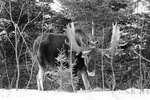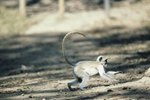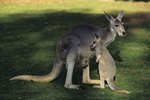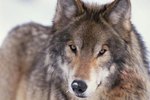
The largest of the deer family, moose (Alces alces) inhabit boreal forests in the northern hemisphere. These herbivores are easily recognized by the trademark enormous antlers sported by the bulls -- which can reach a spread of six feet -- a long muzzle, long legs and a dewlap that hangs from their neck. Four subspecies are recognized in North America, but the divisions are less clear in Eurasia.
Alaskan Moose
The Alaskan moose (A. a. gigus) is the largest subspecies, with males sometimes growing to 6 feet tall and weighing 1,600 pounds. Black-brown with paler legs, these moose range over most of Alaska and parts of western Yukon in Canada. Population is estimated at around 225,000, and about 7,000 are harvested each year in Alaska.
Northwestern Moose
Also referred to as the Western moose, A. a. andersoni is a medium-sized subspecies, standing up to 6 ½ feet high at the shoulder, brownish-black in color, that inhabits areas to the east and south of the Alaska moose. This subspecies has a large range that includes British Columbia, Manitoba, Saskatchewan, Alberta, Ontario, Nunavut, Northwest Territories and Yukon. Its range also covers northern parts of Minnesota, North Dakota, Wisconsin and Michigan. Population estimates are around 380,000.
Eastern Moose
A subspecies similar in size to the northwestern moose, the eastern moose can be found from the the Hudson Bay to the Great Lakes in Nova Scotia, Quebec, Newfoundland and Ontario in Canada. In the U.S., about 30,000 inhabit Maine, and some expansion has occurred south to Connecticut and Massachusetts. Estimates place the population at around 290,000. This subspecies is often described as mahogany brown.
Sheras Moose
The smallest subspecies of moose in North America, A. a. sherasi also has the most southernly range. About 25,000 reside in the Rocky Mountain states and provinces of Wyoming, Idaho, Montana, Utah, Colorado, British Columbia and Alberta, with the range extending into northeastern Washington. Often a paler grayish-brown, the largest can still reach six feet in height and weigh 1,200 pounds.
Eurasian Moose
Eurasian moose (A. a. alces) also called elk in Europe, tend to be darker with lighter legs than their North American counterparts. There is disagreement among taxonomists as to whether the Eurasian Elk is a different species from the North American moose, but several subspecies are recognized: including the European elk, the Siberian (Yakut) moose, the west Siberian (Ussuri) moose, and the east Siberian (Kolyma) moose. About 2 million range across the northern portions of Europe and Asia, from Siberia to Finland and Norway.
References
Photo Credits
-
Jupiterimages/Photos.com/Getty Images
Writer Bio
Leslie Darling has been a writer since 2003, writing regularly for "Mississippi Magazine" and "South Mississippi Living," specializing in food and wine, animals and pets, and all things Southern. She is a graduate of the University of New Orleans.




